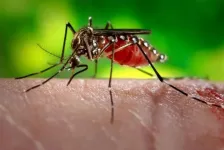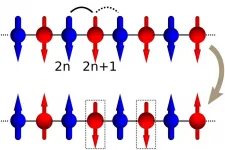(Press-News.org) LOGAN, UTAH, USA -- You might not like mosquitoes, but they like you, says Utah State University biologist Norah Saarman. And where you lead, they will follow.
In addition to annoying bites and buzzing, some mosquitoes carry harmful diseases. Aedes aegypti, the so-called Yellow Fever mosquito and the subject of a recent study by Saarman and colleagues, is the primary vector for transmission of viruses causing dengue fever, chikungunya and Zika, as well as yellow fever, in humans.
"Aedes aegypti is an invasive species to North America that's become widespread in the eastern United States," says Saarman, assistant professor in USU's Department of Biology and the USU Ecology Center, whose research focuses on evolutionary ecology and population genomics. "We're examining the genetic connectivity of this species as it adapts to new landscapes and expands its range."
With Evlyn Pless of the University of California, Davis and Jeffrey Powell, Andalgisa Caccone and Giuseppe Amatulli of Yale University, Saarman published findings from a machine-learning approach to mapping landscape connectivity in the February 22, 2021 issue of the Proceedings of the National Academy of Sciences (PNAS).
The team's research was supported by the National Institutes of Health.
"We're excited about this approach, which uses a random forest algorithm that allows us to overcome some of the constraints of classical spatial models," Saarman says. "Our approach combines the advantages of a machine-learning framework and an iterative optimization process that integrates genetic and environmental data."
In its native Africa, Aedes aegypti was a forest dweller, drawing sustenance in landscapes uninhabited or scarcely populated by humans. The mosquito has since specialized to feed on humans, and thrives in human-impacted areas, favoring trash piles, littered highways and well-irrigated gardens.
"Using our machine-learning model and NASA-supplied satellite imagery, we can combine this spatial data with the genetic data we have already collected to drill down into very specific movement of these mosquitoes," Saarman says. "For example, our data reveal their attraction to human transportation networks, indicating that activities such as plant nurseries are inadvertently transporting these insects to new areas."
Public officials and land managers once relied on pesticides, including DDT, to keep the pesky mosquitoes at bay.
"As we now know, those pesticides caused environmental harm, including harm to humans," she says. "At the same time, mosquitos are evolving resistance to the pesticides that we have found to be safe for the environment. This creates a challenge that can only be solved by more information on where mosquitos live and how they get around."
Saarman adds the rugged survivors are not only adapting to different food sources and resisting pesticides, they're also adapting to varied temperatures, which allows them to expand into colder ranges.
Current methods to curb disease-carrying mosquitoes focus on biotechnological solutions, including cutting-edge genetic modification.
"We hope the tools we're developing can help managers identify effective methods of keeping mosquito populations small enough to avoid disease transmission," Saarman says. "While native species play an important role in the food chain, invasive species, such as Aedes aegypti pose a significant public health risk that requires our vigilant attention."
INFORMATION:
Adolescents and teens may be more likely to be bullied by their friends -- and friends-of-friends -- than classmates they don't know as well, according to a new study.
Diane Felmlee, Distinguished Professor of Sociology and Demography at Penn State and researcher on the paper, said the findings give new insight into how and why bullying occurs -- important information for anti-bullying efforts.
"People often assume that bullying occurs between relative strangers, or that it targets those on the fringes of the social network," Felmlee said. "Those do occur, but in our study, we find that the rate of peer aggression is significantly higher between those students who are closely linked. Furthermore, our finding is not due to friends simply spending ...
In a new study out of University of California San Diego School of Medicine, researchers have identified a universal strain of bacteria derived from healthy human skin that can treat the most common type of eczema, also known as atopic dermatitis.
In the paper published Feb. 22, 2021, in Nature Medicine, the research team investigated the safety and mechanisms of this certain bacteria in a first-in-human, Phase I, double-blinded clinical trial looking to treat people living with eczema. Of the 54 participants, two-thirds reported improvements in their ...
The diversity and numbers of wild salmon in Northern B.C. have declined approximately 70 per cent over the past century, according to a new Simon Fraser University study.
Researchers drawing on 100-year-old salmon scales report that recent numbers of wild adult sockeye salmon returning to the Skeena River are 70 per cent lower than 100 years ago. Wild salmon diversity in the Skeena watershed has similarly declined by 70 per cent over the last century.
The research undertaken by Simon Fraser University (SFU) and Fisheries and Oceans Canada was published today in the Journal of Applied Ecology.
The research team applied modern genetic tools to salmon scales collected from commercial ...
Boston, Mass. - Even with more than 1.5 million Americans receiving a COVID vaccine each day, officials estimate it will take many more months before enough people are protected from the deadly virus. Until then, and potentially beyond, experts agree that opening up schools, restaurants and other public places as safely as possible will rely on widespread testing for SARS-CoV-2, the virus that causes COVID-19.
As of June 2020, the U.S. Food and Drug Administration (FDA) had granted emergency use authorization for more than 85 different viral DNA test kits -- or assays -- each with widely varying degrees of sensitivity and unknown rates of accuracy. However, with no existing gold standard test for the novel coronavirus, there's little data on which ...
A paper recently published in the scientific journal Stem Cells and Development shares an important advancement in conservation -- one that may make the difference between survival and extinction for wildlife species that have been reduced to very small population sizes. Using fibroblast cells that have been preserved in San Diego Zoo Global's Frozen Zoo®, scientists have been able to generate induced pluripotent stem cells of northern and southern white rhinoceroses. This important breakthrough is the first step in a complex process for generating gametes from deceased and non-reproductive individuals of these two subspecies.
"For the northern white rhino, which is functionally extinct, the only hope for survival may be in the ...
ITHACA, N.Y. - Cornell University scientists have identified a new contender when it comes to quantum materials for computing and low-temperature electronics.
Using nitride-based materials, the researchers created a material structure that simultaneously exhibits superconductivity - in which electrical resistance vanishes completely - and the quantum Hall effect, which produces resistance with extreme precision when a magnetic field is applied.
"This is a beautiful marriage of the two things we know, at the microscale, that give electrons the most startling ...
LOS ALAMOS, N.M., Feb. 22, 2021--A team of quantum theorists seeking to cure a basic problem with quantum annealing computers--they have to run at a relatively slow pace to operate properly--found something intriguing instead. While probing how quantum annealers perform when operated faster than desired, the team unexpectedly discovered a new effect that may account for the imbalanced distribution of matter and antimatter in the universe and a novel approach to separating isotopes.
"Although our discovery did not the cure the annealing time restriction, it brought a class of new physics problems that can now be studied with quantum annealers without requiring they be too slow," said Nikolai Sinitsyn, a theoretical physicist at Los Alamos National ...
HOUSTON - (Feb. 22, 2021) - Governments with strong female representation are more likely to deliver on campaign promises, according to new research from Rice University.
"The Effects of Women's Descriptive Representation on Government Behavior" by author Jonathan Homola, an assistant professor of political science at Rice, examines campaign promises and subsequent policymaking by parties in power in 10 European countries, the United States and Canada along with data on women in party leadership and elected offices.
The study also showed that promises are even more likely to be kept when women in government assume leadership roles.
Homola said the research demonstrates the importance of women playing part in the ...
Researchers at the Center for Advanced Bioenergy and Bioproducts Innovation (CABBI) found that transitioning land enrolled in the Conservation Reserve Program (CRP) to bioenergy agriculture can be advantageous for American landowners, the government, and the environment.
Land enrolled in the CRP cannot currently be used for bioenergy crop production, wherein high-yielding plants (like miscanthus and switchgrass) are harvested for conversion into marketable bioproducts that displace fossil fuel- and coal-based energy. Established by the U.S. Department of Agriculture in 1985, the CRP incentivizes landowners to retire environmentally ...
A new study by an international team of researchers found that adults with Down syndrome are more likely to die from COVID-19 than the general population, supporting the need to prioritize vaccinating people with the genetic disorder.
Investigators found that adults with Down syndrome were roughly three times more likely to die from COVID-19 than the general population. This increased risk was especially apparent in from fifth decade of life: A 40-year-old with Down syndrome had a similar risk of dying from COVID-19 as someone 30 years older in the general population.
The study was published this week in The Lancet's ...



